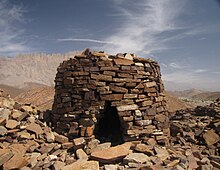At Aybut Al Auwal in the Dhofar region of Oman a site was discovered in 2011 containing more than 100 surface scatters of stone tools belonging to a regionally-specific African lithic industry - the late Nubian Complex - known previously only from the northeast and Horn of Africa. Two optically stimulated luminescence age estimates place the Arabian Nubian Complex at 106,000 years old. This supports the proposition that early human populations moved from Africa into Arabia during the Late Pleistocene.[1]
The departure of mankind from Africa to colonise the rest of the world involved them crossing the Straits of Bab el Mandab in the southern Red Sea and moving along the green coastlines around Arabia and thence to the rest of Eurasia. That crossing became possible when sea level had fallen by more than 80 m to expose much of the shelf between southern Eritrea and Yemen; a level that was reached during a glacial stadial from 60 to 70 ka as climate cooled erratically to reach the last glacial maximum. From 135,000 to 90,000 years ago tropical Africa had megadroughts which drove the humans from the land towards the sea shores and forced them to cross over to other continents.The researchers used radiocarbon dating techniques on pollen grains trapped in lake bottom mud to establish vegetation over the ages of the Malawi lake in Africa. The researchers took samples at 300-year-intervals. Samples from the megadrought times had little pollen or charcoal, suggesting sparse vegetation with little to burn. The area around Lake Malawi, which today is heavily forested was a desert 135,000 to 90,000 years ago.
There have been discoveries of Palaeolithic stone tools in caves in southern and central Oman, and in the United Arab Emirates close to the Straits of Hormuz at the outlet of the Persian Gulf (UAE site (Jebel Faya), Ref: Armitage, S.J. et al. 2011. Ref2: The southern route ‘out of Africa’: evidence for an early expansion of modern humans into Arabia. Science, v. 331, p. 453-456). The stone tools, some up to 125,000 years old, resemble those made by humans in Africa around the same period.
Luminescence dating is a technique that measures naturally occurring radiation stored in the sand. Luminescence dating data showed that 130,000 years ago, the Arabian Peninsula was relatively more warm which caused more rainfall, turning it into a series of lush habitable land. During this period the southern Red Sea’s levels dropped and was only 2.5 miles or 4 km wide. This offered a brief window of time for humans to easily cross the sea and cross the Peninsula to opposing sites like Jebel Faya. These early migrants running away from the climate change in Africa, crossed the Red Sea into Yemen and Oman, trekked across Arabia during favourable climate conditions. 2,000 kilometres of inhospitable desert lie between the Red Sea and Jebel Faya in UAE. But around 130,000 years ago the world was at the end of an ice age. The Red Sea was shallow enough to be crossed on foot or on a small raft, and the Arabian peninsula was being transformed from a parched desert into a green land

